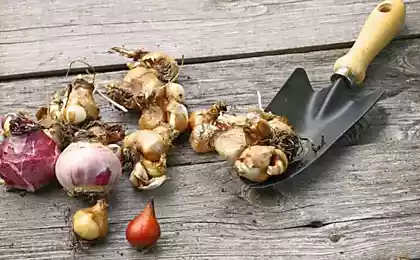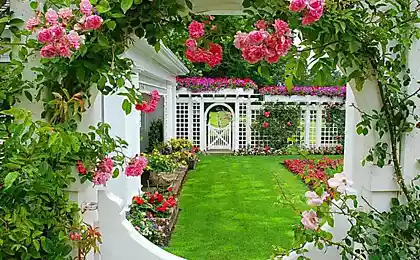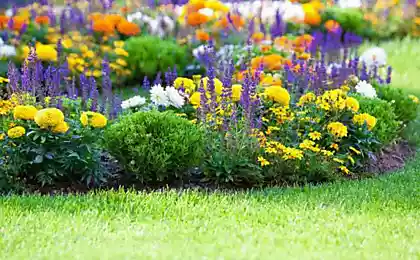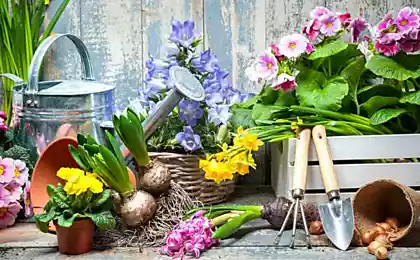493
August: the main work in the flower garden
1. The main work in the flower garden in August is planting new perennials and transplanting too overgrown and rejuvenation of outdated.
But above all, it is necessary to prepare the site for planting, and therefore to undertake a transplant or buy new planting material. The majority of gardeners do just the opposite. Go to numerous exhibitions, which are held at this time, and buying all of Opera eyes. Can be seated or to plant anew the astilba, comfrey, Solomon's seal, bleeding heart, Phlox, bluebells, irises, swimsuit, Badan, feverfew, Solidago, peonies.
Sixty seven million four hundred thirty two thousand one hundred fourteen
Rhizomatous perennials need to oblati on all sides, remove the plant along with the clod of earth on his side. A strong jet of water from a hose to dilute the rhizome, freeing him from the earth. Rhizomes with a sharp knife cut only those plants (e.g., astilba, pyrethrum), in which it is impossible to break apart with your hands.
Divide the rhizome is necessary so that each delenki was kidney regeneration. The sections immediately add dry ash or grease zelenkoj or hydrogen peroxide. But you can wash wounds with a solution of any product containing copper.
2. If pions were brown spots on the leaves or they reddened, and especially if the stems off right at the base where the formed black rot, the pion, it is necessary to dig carefully and check the rhizome, peony sick as Fusarium. All the rotten parts of the rhizome should be carefully cut out, and even better to share this peony on a separate them out.
Clean wounds, as mentioned above, and sprinkle them with ash. Only after that the peony can be transplanted, and better in the new location. Peony does not like acidic soils, stagnant water, too dry landing site, clay. You put it for decades, so the planting hole should be at least of size 60×60×60 cm and is filled with well-rotted compost, but it is impossible to make a peony manure.
It should not be planted closer than two meters from the walls of houses or the trunks of large trees. Bury the rhizome should be only 4-5 see Peony loves silicon. Put delinko directly in a woolen mitten or sock, or backfill when planting under delinqu a handful of old feather pillows. Hair and feathers – pure organic silicon.
To rejuvenate the pion, and this should be done once in 10 years, it is necessary to apkopoti from all sides and turn to the side. All further actions to be carried out, as in digging the patient peony. But a healthy plant that started to bloom poorly, you can simply rejuvenate, cutting off from it a part on the one hand a strong blow with a sharp shovel.
Then the severed part to dig up and transplant, fill the cuts with ash. In the formed hole is also to make ash (not less than a glass) and fill it with fertile land. A year later, the operation should be repeated on the other side of the Bush.
3. Divide Phlox – mandatory event every 3-4 years.
The fact that the rhizome of Phlox annually acquires young rootlets branching directly into root of the neck. Kidney regeneration are at the base of last year's shoots, that is almost on the soil surface. Annually growing, the root system begins to bulge upward together with the kidneys resume is unprotected from frost.
In addition, aging gradually destroyed the middle of the Bush. Bush should be dug, to blur the water and roots to divide the plant, cut out the old middle. If the floral arrangement you want, and you don't want to change it, just change the ground under the Phlox and planted them at the same place. But don't forget in spring and autumn to pour fresh breeding ground under the Phlox.
With good care, fertilizing and timely watering the Phlox can grow in one place up to 7 years. Indicator well-being is Nausicaa greens on the bottom of the stems. But if Phlox bottom dry out, and in the spring grows dwarf shoots, the urgent their loans without waiting for August or risk losing the plants.
The phloxes need a fertile neutral, constantly moderately moist soil. In full sun the Phlox bloom early and fade faster. Is best suited in partial shade. In the shadow is strongly affected by powdery mildew.
Nineteen million three hundred sixty seven thousand twenty one
4. Under the astilba, too, should pour the soil, otherwise it will not bloom or will bloom sickly.
The rhizome is growing up, and kidney regeneration, located at the base of last year's stems are above the ground. To plant, divide and replant her best in August. The plant is undemanding and grateful. With a minimum care, it blooms profusely, long and many years in one place. If necessary, you can rejuvenate the bushes, just as the peonies.
Astilba grows well in partial shade and even shade, in the sun, it quickly fades. Prefers slightly acidic soil, very responsive to mineral supplements, but ash better not to get involved. In early spring the young shoots can be damaging spring frosts, but it's not scary, instead they will grow a new one. Cvetochki can die only if you didn't put the bushes under the soil.
Like all shade-loving plants, astilbe love moisture, but this does not mean that they can be planted in low, flooded areas. Combined with the watershed and facilityname and saxifrage because of the identical conditions of existence, in addition, this group of plants in bloom almost all season, one after another. It is possible to plant fall Aster and Solidago, though both groups prefer a Sunny location, but partial shade grow and bloom, however, somewhat later than in the Sunny hillside.
5. In August lilies bloom pertaining to Oriental hybrids, as well as the so-called Sarankov (tiger, leopard).
The Lily – plants are undemanding. Reproduction occurs air the little bulbils that appear on the stems. Once they start to hatch the spine, remove them from the stems and put in a new plantation for rearing. Planting depth of 3-4 cm, but in the winter they should cover, and early spring cover to remove. In the following August, transplant them in place.
Eastern hybrids in the North-West – plants problem. As I wrote before, they do not tolerate cold wet weather, and we have it just like that during flowering. Therefore, as a rule, they develop Botrytis.
In winter, Oriental hybrids have to cover. If you cover them with peat to a height of about 20 cm, this will be enough, but in the spring they should be on turf (or other shelter) to release early, otherwise they will prematurely sprout and the beginnings of the buds will get under freezing.
If early spring bulbs purchased Easterners to plant in the greenhouse, they will bloom earlier. Because lilies are easily transferred to transplant in greens they can be planted in open ground in a moment of intense growth of the buds.
Most importantly – when transplanting not to damage the roots and not allow them to curl up. In this case it is possible to do without Botrytis, because the flowering will be in late July. But to hide, of course for the winter will have. In the spring the peat is not removed as soon as sprouts, and dug, and again transplanted in the greenhouse.
At the same time necessary to dig up and replant the Lily species of Asian hybrids. Each formed for some years the nest dug out in its entirety. In this case, you should know that lilies can deviate from the bulbs, but because the excavation of a nest start away from the stems, otherwise you can chop with a shovel or pitchfork to damage the bulbs.
The soil from the roots should be shaken gently with your hands to divide the bulbs. If the upper scales are rotted or covered with brown spots, they should be separated and discarded. Lilies do not dry, on the contrary, they should be immediately after digging to transplant to a new location. If you haven't prepared for the landing, you can slightly trim off the roots, hold the bulbs for a short time in boxes or open plastic bags in moist peat or moss.
The bulbs easily lose viability during the drying of the roots. Therefore, acquiring planting material, pay attention to the condition of the roots of the bulbs. If the roots have dried out, the onion should not be buying. Planting bulbs too in August, but you can spring.
Forty eight million five hundred thirty one thousand three hundred eighty nine
6. You have blooming roses in August should not be taken wither flowers so as not to cause the formation of new shoots.
7. The annuals should always remove the fading flowers to prolong flowering. Leave only a few of these flowers to get their seeds. Recall that hybrids do not give a full-fledged offspring, and therefore to collect from them seeds makes no sense.
Sanitation unit in the country: the most simple methods of sewage disposal
Basement waterproofing: choosing the best way
8. Take care of the perennials and the biennials of the early flowering times (Daisy, Armeria municipality, saxifrage, primrose, pechenocnae, alyssum ), and groundcover plants. They have formed numerous new outlets. In order to isolate them, to transplant and to propagate, it is necessary to dig (except groundcover) in its entirety, dismantle, breaking hands, rhizomes, and seat. This is especially true of primroses since these plants are maloletnimi.
If they do not share every two years, they simply disappear. The same is true of delphiniums They definitely should sit every three years, otherwise you risk losing them. Groundcover give rosettes at the ends of his mustache. Seated the socket enough to cut from the mother plant and transplant to a new location without disturbing the parent.published
P. S. And remember, just changing your mind — together we change the world! ©
Source: www.facebook.com/worldofplantsru/posts/1735069800089072:0
But above all, it is necessary to prepare the site for planting, and therefore to undertake a transplant or buy new planting material. The majority of gardeners do just the opposite. Go to numerous exhibitions, which are held at this time, and buying all of Opera eyes. Can be seated or to plant anew the astilba, comfrey, Solomon's seal, bleeding heart, Phlox, bluebells, irises, swimsuit, Badan, feverfew, Solidago, peonies.
Sixty seven million four hundred thirty two thousand one hundred fourteen
Rhizomatous perennials need to oblati on all sides, remove the plant along with the clod of earth on his side. A strong jet of water from a hose to dilute the rhizome, freeing him from the earth. Rhizomes with a sharp knife cut only those plants (e.g., astilba, pyrethrum), in which it is impossible to break apart with your hands.
Divide the rhizome is necessary so that each delenki was kidney regeneration. The sections immediately add dry ash or grease zelenkoj or hydrogen peroxide. But you can wash wounds with a solution of any product containing copper.
2. If pions were brown spots on the leaves or they reddened, and especially if the stems off right at the base where the formed black rot, the pion, it is necessary to dig carefully and check the rhizome, peony sick as Fusarium. All the rotten parts of the rhizome should be carefully cut out, and even better to share this peony on a separate them out.
Clean wounds, as mentioned above, and sprinkle them with ash. Only after that the peony can be transplanted, and better in the new location. Peony does not like acidic soils, stagnant water, too dry landing site, clay. You put it for decades, so the planting hole should be at least of size 60×60×60 cm and is filled with well-rotted compost, but it is impossible to make a peony manure.
It should not be planted closer than two meters from the walls of houses or the trunks of large trees. Bury the rhizome should be only 4-5 see Peony loves silicon. Put delinko directly in a woolen mitten or sock, or backfill when planting under delinqu a handful of old feather pillows. Hair and feathers – pure organic silicon.
To rejuvenate the pion, and this should be done once in 10 years, it is necessary to apkopoti from all sides and turn to the side. All further actions to be carried out, as in digging the patient peony. But a healthy plant that started to bloom poorly, you can simply rejuvenate, cutting off from it a part on the one hand a strong blow with a sharp shovel.
Then the severed part to dig up and transplant, fill the cuts with ash. In the formed hole is also to make ash (not less than a glass) and fill it with fertile land. A year later, the operation should be repeated on the other side of the Bush.
3. Divide Phlox – mandatory event every 3-4 years.
The fact that the rhizome of Phlox annually acquires young rootlets branching directly into root of the neck. Kidney regeneration are at the base of last year's shoots, that is almost on the soil surface. Annually growing, the root system begins to bulge upward together with the kidneys resume is unprotected from frost.
In addition, aging gradually destroyed the middle of the Bush. Bush should be dug, to blur the water and roots to divide the plant, cut out the old middle. If the floral arrangement you want, and you don't want to change it, just change the ground under the Phlox and planted them at the same place. But don't forget in spring and autumn to pour fresh breeding ground under the Phlox.
With good care, fertilizing and timely watering the Phlox can grow in one place up to 7 years. Indicator well-being is Nausicaa greens on the bottom of the stems. But if Phlox bottom dry out, and in the spring grows dwarf shoots, the urgent their loans without waiting for August or risk losing the plants.
The phloxes need a fertile neutral, constantly moderately moist soil. In full sun the Phlox bloom early and fade faster. Is best suited in partial shade. In the shadow is strongly affected by powdery mildew.
Nineteen million three hundred sixty seven thousand twenty one
4. Under the astilba, too, should pour the soil, otherwise it will not bloom or will bloom sickly.
The rhizome is growing up, and kidney regeneration, located at the base of last year's stems are above the ground. To plant, divide and replant her best in August. The plant is undemanding and grateful. With a minimum care, it blooms profusely, long and many years in one place. If necessary, you can rejuvenate the bushes, just as the peonies.
Astilba grows well in partial shade and even shade, in the sun, it quickly fades. Prefers slightly acidic soil, very responsive to mineral supplements, but ash better not to get involved. In early spring the young shoots can be damaging spring frosts, but it's not scary, instead they will grow a new one. Cvetochki can die only if you didn't put the bushes under the soil.
Like all shade-loving plants, astilbe love moisture, but this does not mean that they can be planted in low, flooded areas. Combined with the watershed and facilityname and saxifrage because of the identical conditions of existence, in addition, this group of plants in bloom almost all season, one after another. It is possible to plant fall Aster and Solidago, though both groups prefer a Sunny location, but partial shade grow and bloom, however, somewhat later than in the Sunny hillside.
5. In August lilies bloom pertaining to Oriental hybrids, as well as the so-called Sarankov (tiger, leopard).
The Lily – plants are undemanding. Reproduction occurs air the little bulbils that appear on the stems. Once they start to hatch the spine, remove them from the stems and put in a new plantation for rearing. Planting depth of 3-4 cm, but in the winter they should cover, and early spring cover to remove. In the following August, transplant them in place.
Eastern hybrids in the North-West – plants problem. As I wrote before, they do not tolerate cold wet weather, and we have it just like that during flowering. Therefore, as a rule, they develop Botrytis.
In winter, Oriental hybrids have to cover. If you cover them with peat to a height of about 20 cm, this will be enough, but in the spring they should be on turf (or other shelter) to release early, otherwise they will prematurely sprout and the beginnings of the buds will get under freezing.
If early spring bulbs purchased Easterners to plant in the greenhouse, they will bloom earlier. Because lilies are easily transferred to transplant in greens they can be planted in open ground in a moment of intense growth of the buds.
Most importantly – when transplanting not to damage the roots and not allow them to curl up. In this case it is possible to do without Botrytis, because the flowering will be in late July. But to hide, of course for the winter will have. In the spring the peat is not removed as soon as sprouts, and dug, and again transplanted in the greenhouse.
At the same time necessary to dig up and replant the Lily species of Asian hybrids. Each formed for some years the nest dug out in its entirety. In this case, you should know that lilies can deviate from the bulbs, but because the excavation of a nest start away from the stems, otherwise you can chop with a shovel or pitchfork to damage the bulbs.
The soil from the roots should be shaken gently with your hands to divide the bulbs. If the upper scales are rotted or covered with brown spots, they should be separated and discarded. Lilies do not dry, on the contrary, they should be immediately after digging to transplant to a new location. If you haven't prepared for the landing, you can slightly trim off the roots, hold the bulbs for a short time in boxes or open plastic bags in moist peat or moss.
The bulbs easily lose viability during the drying of the roots. Therefore, acquiring planting material, pay attention to the condition of the roots of the bulbs. If the roots have dried out, the onion should not be buying. Planting bulbs too in August, but you can spring.
Forty eight million five hundred thirty one thousand three hundred eighty nine
6. You have blooming roses in August should not be taken wither flowers so as not to cause the formation of new shoots.
7. The annuals should always remove the fading flowers to prolong flowering. Leave only a few of these flowers to get their seeds. Recall that hybrids do not give a full-fledged offspring, and therefore to collect from them seeds makes no sense.
Sanitation unit in the country: the most simple methods of sewage disposal
Basement waterproofing: choosing the best way
8. Take care of the perennials and the biennials of the early flowering times (Daisy, Armeria municipality, saxifrage, primrose, pechenocnae, alyssum ), and groundcover plants. They have formed numerous new outlets. In order to isolate them, to transplant and to propagate, it is necessary to dig (except groundcover) in its entirety, dismantle, breaking hands, rhizomes, and seat. This is especially true of primroses since these plants are maloletnimi.
If they do not share every two years, they simply disappear. The same is true of delphiniums They definitely should sit every three years, otherwise you risk losing them. Groundcover give rosettes at the ends of his mustache. Seated the socket enough to cut from the mother plant and transplant to a new location without disturbing the parent.published
P. S. And remember, just changing your mind — together we change the world! ©
Source: www.facebook.com/worldofplantsru/posts/1735069800089072:0
Ayurvedic self-massage: a simple technique for your health
Audi has created a suspension with the function of generating electricity


















